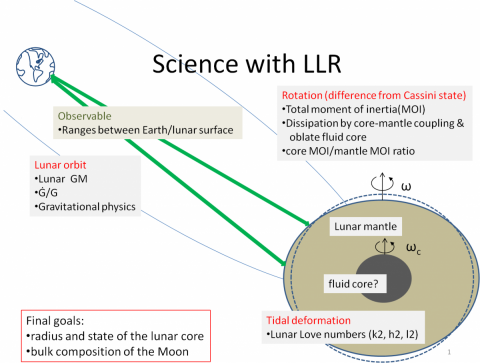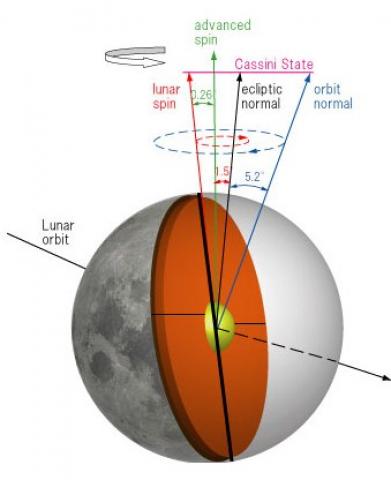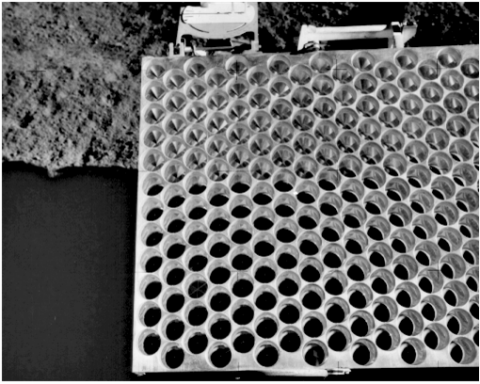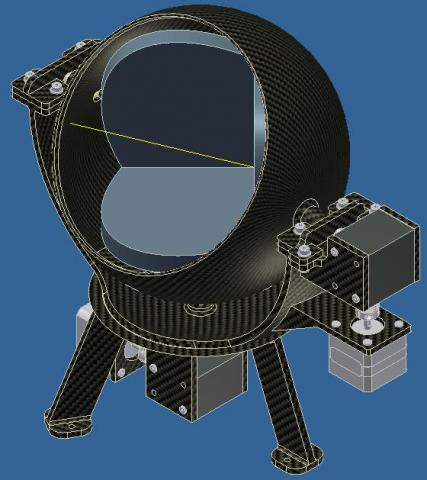Exploring the lunar interior by rotation and tides
LLR (Lunar Laser Ranging) is a technique which measures distance between the lunar surface and Earth surface, by using high power ground laser which is bounced off with retroreflectors on the lunar surface which were installed by Apollo mission of U.S.A. and Luna mission of former USSR.
The moon always faces its one side toward the Earth (this face called ‘near-side’) because of the synchronous rotation between rotation and orbit motion. When the Moon was formed, it must have rotated much faster than now. The rotation rate must have become much slower through exchange of angular momentum between the Earth and the Moon. The LLR data had revealed that the current Moon has slightly advanced spin phase compared to the ‘Cassini state’, in which the orbit normal, rotational axis, and the ecliptic normal become coplanar. It might be because the energy is lost due not only to the tide of viscoelastic mantle but also to the friction between the mantle and the fluid core. New retroreflectors on the moon will be beneficial to determine more accurate rotational changes for better understanding of the lunar interior structure.
The distance between the lunar surface and the Earth surface by LLR contains both rotational changes and lunar solid tides. Tides of the Earth’s ocean are caused by the tidal force from the Moon. The same thing occurs on the lunar solid surface; the lunar shape is slightly modified to a shape like a rugby ball due to the tidal force from the Earth. As is described above, because the near-side of the Moon faces toward the Earth direction, the main component of the tides is fixed offset. However, if we look at the Earth from the lunar surface, the position of the Earth changes periodically with amplitude of about 10 degrees. Accordingly, the displacement of the lunar surface also changes periodically. The amount of this displacement depends on how soft the lunar interior is. This explains why the lunar interior can be studied through the lunar tides.
New retroreflectors on the Moon !
The 80 % of total range data come from the Apollo 15 retroreflector because it is three times as large as others. We are aiming to put a new high-accuracy retroreflector to a distant place from the Apollo 15 site (more than 2000 km) on the Moon.
The Apollo retroreflectors contain 100 or 300 of corner cube prisms with 3.8cm diameter aperture. It is a good design in terms of survival of large day-night temperature differences, however, because of the libration, the width of the return pulse becomes longer which causes less accurate ranging than a few cm. Therefore, we are developing a single large-aperture retroreflector in collaboration with National Institute of Information and Communications Technology (NICT), Hitotsubashi University and other researchers in Japan, aiming to be one of the payloads of the SELENE-2. Also, we are working under a collaboration agreement between University of Maryland (UMD), U.S.A., and Istituto Natzionale di Fisica Nucleare, Laboratori Nazionali di Frascati (INFN-LNF), Italy.
Other new retroreflectors from other countries’ landers will form stronger LLR network on the lunar surface.
Domestic ground station
In Japan, Japan Aerospace Exploration Agency (JAXA), NICT, and Hydrographic and Oceanographic Department of Japan Coast Guard (JCG) have ground laser stations for satellite laser ranging (SLR). However no SLR stations in Japan can range the Moon due to the less laser power and small telescope aperture size. We would like to develop a domestic telescope for LLR whose diameter is 1.5 m-class.

Fig.1:Science with LLR

Fig.2:The shift from the Cassini state

Fig.3:The retroreflector of Appollo 15 sites (credit NASA)

Fig.4:Conceptual drawing of a new retroreflector (credit iSpaceLab., Iwate Unversity)